Brief
Sometimes the future appears right before your eyes, but it’s hard to see. For insurance companies, the future is taking shape in companies like the Climate Corporation.
Software engineers and data scientists who had previously worked at Google and other Silicon Valley firms started the Climate Corporation eight years ago. Since then it has upended the US crop insurance market, reducing farmers’ financial risks by crossing agriculture with Big Data analytics.
The company collects information on weather patterns, climate trends and soil characteristics, then crunches the data down to a farmer’s field in, say, Iowa. Using these insights, it offers policies against damage from weather events. Farmers can work with independent local agents or directly interact through the Climate Corporation’s website. Its payouts complement federal crop insurance, which provides only limited coverage. In contrast to government schemes, payouts are triggered automatically without paperwork when the company’s data shows that a weather event has caused damage. The Climate Corporation has generated strong revenue growth in both insurance and advisory services to farmers about how to raise crop yields. Now it sees potential to take its weather analytics to other countries and possibly to other industries affected by climate change.
With its applied Big Data expertise, convenient interface for customers, innovative claims process and proven track record, the company would have seemed an attractive acquisition for a major insurance company. In fact, its model had been presented to insurers by the Anthemis Group, an early funder and adviser that specializes in financial services start-ups. Yet late last year, Monsanto acquired the Climate Corporation for $930 million.
This missed opportunity for deep-pocketed insurers is emblematic of the digital-progress gap between insurance and many other industries, such as banking, telecommunications and retailing. Like the Climate Corporation, a growing number of start-ups are using innovative business models and digital expertise to try to carve out lucrative niches in insurance.
The digital imperative is no longer in question, largely because insurance customers expect to use the channel that’s convenient to the moment. Bain & Company’s recent survey of more than 158,000 consumers in 18 countries found that the share of digitally active customers ranges from 35% to 70%, and over the next three to five years, 79% of consumers said they will use a digital channel for insurance interactions (see Figures 1 and 2).
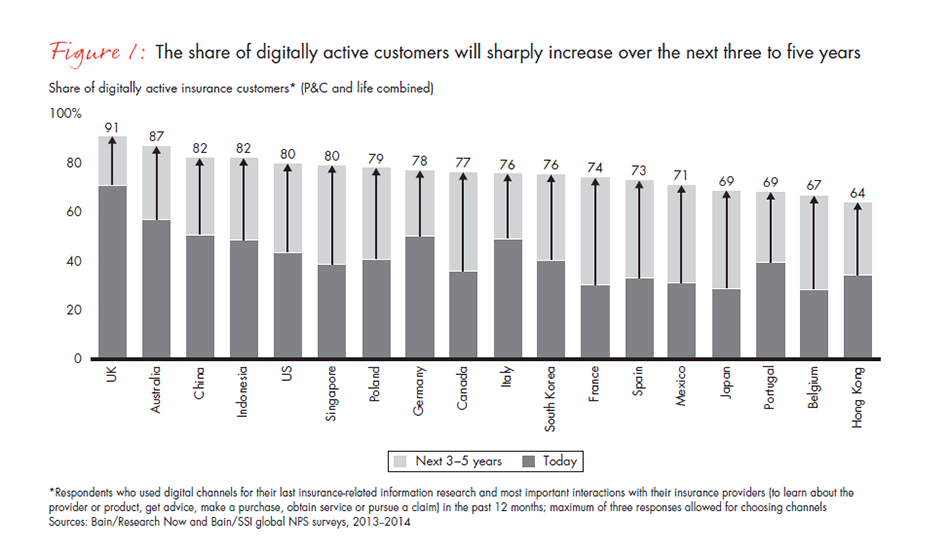
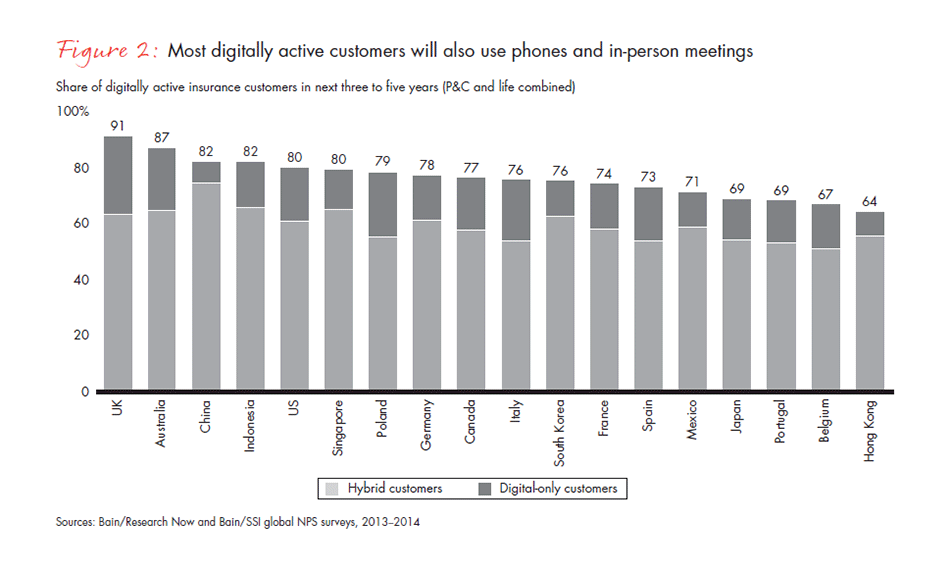
But digital tools and processes do not replace everything physical. Insurance customers still benefit from talking with an agent or a claims representative when dealing with complex products or transactions. Customers have woven together their digital and physical worlds so tightly and seamlessly that they can’t fathom why companies wouldn’t do the same.
Indeed, there’s compelling evidence that a strong Digical® offering—one that fuses the best of digital and p worlds—results in greater customer loyalty and advocacy. A customer who uses both digital and physical channels gives her insurance carrier a much higher Net Promoter ScoreSM (Bain’s measure of loyalty), on average, than does a customer who uses only digital channels.
Greater loyalty, in turn, flows through to the economics of insurance companies. Bain estimates that, across several country markets, a customer who is a promoter of his carrier is worth nearly seven times the lifetime value of a customer who is a detractor.
Leading companies such as Progressive, USAA, Allianz, Direct Line and AXA are starting to realize the promise of the Digical transformation. Some are improving customers’ overall experience by developing advanced analytics capabilities to better understand customers’ priorities. Others are building out digital channels for faster, easier transactions and communications, such as mobile applications for auto and health claims processing. And some are reducing cost, error rates and rework by shifting from repeated manual data entry to electronic straight-through processing.
The case for digitization is clear, but we often see one of two extreme reactions. At one extreme, some companies hope the digital hype will die down; they risk losing market share to faster-moving incumbents or to disruptive new entrants like the Climate Corporation.
At the other extreme, companies that hastily pursue a string of unconnected initiatives risk squandering large investments that yield little return.
Even for executives who know they have to make digital investments over the coming years, it’s not clear exactly where to start and how to proceed with making investments, organizing for innovation, forming partnerships and addressing other areas that will need to be redesigned. The danger is that they will make big bets, such as launching independent digital businesses or platforms for transactional products, without thinking through the underlying demand rationale.
Bain Partner Henrik Naujoks discusses the four key questions leading insurers are asking themselves.
Based on the early results from digital insurance initiatives, combined with lessons from other industries, we have identified four questions that can anchor a balanced, pragmatic approach. Addressing these questions will help executives chart the right course for their organization:
- How much of our business do we need to digitize? Considerations include a company’s current digital footprint and a thoughtful articulation of what it aims to accomplish.
- What’s the right pace for our Digical transformation program? Most companies will choose to be fast followers, but a few can succeed as forerunners.
- Should our digital offerings be separate from or integrated with the core business? Executives need to decide how the traditional business and a digital offering can coexist most effectively.
- How can we reduce the risks inherent in a transformation? The organization’s readiness for major change is a key factor.
How much of our business do we need to digitize?
In most countries and most lines of business, insurance has not been moving quickly with digital innovation. Along a continuum from slow- to fast-moving (see Figure 3), the property and casualty (P&C) sector falls in the middle of the road, though it’s more advanced in some countries and lines of business (for instance, with auto coverage in the UK). The life sector has progressed more slowly in most countries, but with direct distribution being introduced to the market, there are signs that it’s accelerating to the middle of the road. What matters most to an individual insurer, though, is how fast it is moving in its markets relative to others, including potential new entrants. Digical innovators in virtually every industry pass through three stages of development, discussed in a recent Bain Brief, “Leading a Digical® transformation.” A company that knows which stage it is in today can better figure out the best relationship between its traditional business and proposed digital innovations. This knowledge can also help successfully guide a company from the current stage to the next.
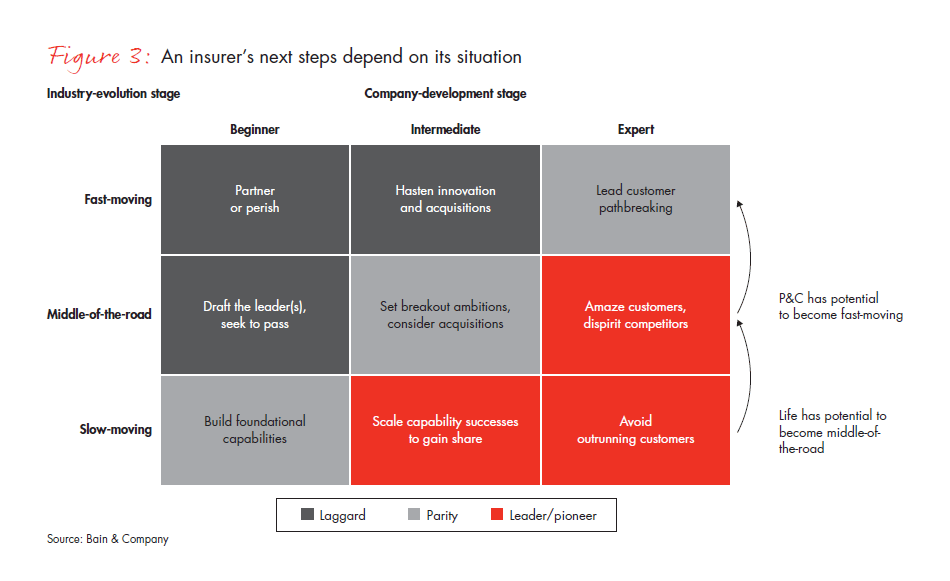
Beginners are still figuring out how to experiment with digital tools. They are still trying to identify their customers’ needs and frustrations. They may be slow to innovate and are likely to have a lot of money invested in older technologies. Their organization is probably siloed, and their culture is most likely conservative. In a middle-of-the-road industry, the beginner has to stay within striking distance of the leaders, even as it masters the basics. We estimate that roughly 60% to 70% of insurance companies fit this category.
Intermediates represent 30% to 40% of insurance companies, and many have launched some Digical initiatives. Instead of merely responding to threats from rivals, they are out to beat the competition. Though many intermediates still have only average infrastructure capabilities, they are testing and learning. They view Digical goals with enthusiasm, though individual units may be protective of their unique skills in this area. Executives often create new performance metrics, such as loyalty or market share metrics of the most attractive Digical customers, to focus the organization’s efforts and build confidence in the new direction. For an intermediate insurer, acquisitions of digitally focused companies may help it break into the lead.
Experts have been at it for a while. They have perceived the possibilities of the Digical revolution and have moved from competitor benchmarking to customer pathbreaking. Organizationally they are one team, with a unified culture and few skills gaps. Typically, experts don’t rest on their laurels. They realize that their own disruptions face the constant threat of newer disruptors. Digical is no longer an add-on; it is part of the way they do business. Expert insurers need to develop and defend proprietary barriers, emphasizing long-term market share over short-term profits. Only a handful of insurance companies have reached this stage, including USAA and Progressive in the US, Discovery in South Africa and perhaps a few direct insurers that are establishing physical agent forces or phone salesforces, such as CosmosDirekt.
The degree of digitization a company needs to undertake will also depend on its point of departure and its specific business goals. Kyobo Life in South Korea realized its captive agent channel was losing share to bancassurance and telephone marketing channels. It perceived an opening to add an online channel before other national life insurers made the move.
One US life insurer, by contrast, views its digital journey as a way to counter continually rising costs, reduce error rates and increase efficiency. It decided to speed up a range of digital initiatives, from online tools for agents to straight-through processing for traditionally manual processes. These initiatives successfully reduced the time to issue a policy as well, delighting both agents and policyholders, and lowering the rate of policies not taken, which can yield a bigger financial benefit than simply reducing costs.
For a major European insurer, the initial impulse was a strategic imperative led by the CEO and an interdisciplinary working group after a “long-term vision” exercise that identified digital as the most disruptive trend. The outcome of that exercise was a programmatic commitment to a highly digital future.
And for a New Zealand P&C insurer, the major digital impetus emerged from concerns about how customers viewed their interactions with the company. The insurer saw customer advocacy eroding because of error-prone, paper-based processes; inflexible customer service; and complex core IT systems.
To understand its current digital state, a company can assess its progress to date along six dimensions (see below):
- Digitally enhanced customer experiences. Insurers need to understand their customers’ digital behaviors and priorities to design the appropriate offerings and customer experience. Young online companies like SureNow and Protect Your Bubble have a head start in this regard, often targeting digitally savvy customers with low-cost insurance products. For incumbent insurers, certain moments of truth, such as filing a claim, will need to be reengineered to integrate digital components.
- An omnichannel sales and distribution model. Customers increasingly expect their insurers to have robust online and mobile channels, with technology integrated seamlessly into activities such as call center conversations. Digital tools, such as tablets used to issue a policy through a completely digital process, will also augment the agents’ toolkit. Dutch insurer Aegon has gone even further by launching Kroodle, a paperless insurance company, designed mainly for mobile users who purchase via Facebook.
- Optimized operations using digital technologies. Digital can play a big role in simplifying operations by trimming redundant and manual processes, while also speeding up turnaround times.
- An innovation-ready organization. Becoming a Digical innovator requires busting through organizational walls and encouraging—through carrots and sticks—active collaboration across functions and business units. Nurturing a culture of innovation also puts a premium on new skills, some of which will come through external hiring.
- Advanced analytics and Big Data applied throughout the business. As the Climate Corporation illustrates, Big Data holds the potential for step-change improvements in customer segmentation, risk calculation, fraud identification and other areas. But the payoff is not instantaneous: It takes time to develop an advanced analytics capability staffed by the right people, then to focus them on highest-priority issues to start generating results.
- Technology activated to enable a Digical transformation. Here, the challenge is to cost-effectively enhance IT infrastructure and capabilities, either internally or through off-the-shelf systems. IT should be explicitly directed to advance those business initiatives that will create the most value and to allow other initiatives to be good enough.
These dimensions serve as a menu of options to help executives decide where they need to make digital investments. The company’s chosen strategy, digital ambition, desired customer experience and its articulation of what it aims to accomplish will inform each decision.
While each Digical journey has to be tailored to the individual organization, there are a few commonalities emerging in the insurance industry. Basic digital initiatives, for instance, often feature online customer self-service and online quotes for simple, transactional products. More advanced capabilities include straight-through processing, policy management applications, claims lodgment and tracking applications, and Big Data analytics that inform pricing and underwriting.
What’s the right pace for our Digical transformation program?
A perennial question in the Digical transformation is how fast to move. Too fast and too slow are equally dangerous.
Jumping out as a digital forerunner requires moving fast enough to stay ahead of competitors and to enter the next stage. Alternatively, deciding to be a fast follower requires drafting behind the forerunners, with a close eye on the competition and on other geographies and industries. Either approach poses opportunities and risks.
Being a forerunner can help a company build or maintain market leadership and scale. Progressive, for instance, has benefited from being out front in in-vehicle telematics and from running thousands of tests a year to systematically vary messages, creative design and delivery channels. And AIA raised efficiency by providing iPads to its agents only a year after Apple introduced the iPad.
One risk that accompanies an early-mover position is prematurely advancing beyond what customers want, so that a tool such as a self-service portal has low customer adoption rates. Another risk is running over an already heavy budget and deadline. A third risk involves inadvertently crossing the boundary of what a regulator will tolerate. For example, one insurer that was using Facebook to detect potential trigger points for selling to customers ran into opposition from regulators in continental Europe on grounds of privacy violations.
For fast followers, there are several advantages. They can watch others test technology and learn from the experiences, possibly deploying the technology better. And their requirements for innovation investment will be lower.
Fast followers do, however, face risks. If digital forerunners succeed with their innovations, they usually will capture some of the fast followers’ customers. Followers also will find it difficult to match the cumulative experience of forerunners, especially in areas like advanced analytics, where it’s critical to test and learn. That may cause followers to lose leadership, scale and talented employees, as well as to sacrifice equity with younger customers, who represent the future.
Both forerunners and fast followers will need to determine which capabilities are absolutely essential to deliver on the chosen strategy and which capabilities can be good enough. It’s likely that they’ll need to hire people with new skills and work with outside experts to develop the key capabilities through outsourcing or partnering.
Some insurers, for instance, have partnered with social media marketing firms to provide agents with online content for customers and prospects. This content is triggered by personal announcements that consumers post online, like “looking for a new car” or “photos of our new daughter.” Other insurers are working with firms that crawl the Web for social content mentioning insurance companies. These vendors compile and analyze that information, presenting the data in a dashboard to insurers, with suggestions on how to engage with customers. Establishing effective partnering models thus is becoming increasingly important for insurers.
Should our digital offerings be separate from or integrated with the core business?
Either a standalone digital business or a Digical fusion that takes the existing brand online can be a viable path. The case for separate or integrated efforts depends on the organization’s point of departure and its goals. Just as with the decision on being a forerunner or fast follower, executives deciding whether to separate or integrate have to carefully weigh the trade-offs. Many insurers will likely pursue a blend of both: separate initiatives for truly disruptive businesses and integrated initiatives for evolving the core business.
A separate digital effort, often with a new brand or a new subsidiary, gives senior management more leeway in its offerings, target customers and pricing structure. The new organization can tailor offerings to customers with a high digital affinity and will likely find it easier than the incumbent business does to attract digitally savvy talent.
Kyobo Life followed that logic when it recently created, through a joint venture with Japan’s Lifenet, a website called Lifeplanet, which offers a no-frills product line. From Kyobo’s standpoint, several reasons argued against moving the core business online: conflict with its agent channel, lack of advanced in-house digital capabilities, and considerable investments required to design and launch the business.
Yet it perceived an opportunity worth pursuing through a separate business. Consumers were showing more self-directed behavior online, and several groups of consumers were receptive to buying life insurance online. Also, an online-only life insurance start-up was doing well in a nearby country, and there were healthy online examples in banking and brokerage.
The risks of a selecting a separate effort start with the high costs of developing a new brand and promoting awareness. Also, as they look for a digital alternative, customers of the existing brand may become disillusioned with the traditional offering and overlook the new brand, which has no established reputation. That would result in more customer defections. And eventually, some separate efforts might need to be integrated back into the core business.
The alternative—transforming the core business by moving the brand online—has several advantages. It addresses customers’ expectations of having more digital options and harnesses the strengths of a well-known brand for new offerings and potentially new markets. It digitizes current operations and the salesforce, which can be more cost-efficient than having to build anew.
Potential downsides start with the possibility that any service problems during the transition may tarnish the brand and annoy customers, who might even defect. Top talent with digital expertise may be harder to find. Also, an online channel may conflict with agents’ sales, causing agents to revolt.
Several factors have to be considered when weighing the decision. First, companies should evaluate how the initiative will affect the current channel. Developing an online sales capability will likely cannibalize existing distribution channels. That can pose a problem when independent agents or brokers, who could take their business elsewhere, are involved.
Second, organizations should assess their capacity for change. If the digital initiative comes on top of other major initiatives, people may feel overloaded and fatigued. Establishing a separate unit may be more productive in that case. For digital to become ingrained, most insurance organizations will need to undergo a significant shift in culture. Executives will need to transform themselves, especially if they are digitally challenged. They could benefit from immersing themselves in digitally intensive settings for at least a few days, acquiring reverse mentors from among their young employees and playing with the technologies that customers use. They can invite technology leaders onto their boards and launch “no executive left behind” training programs. Employees in IT departments, meanwhile, will need to acquire a better understanding of end customers, not just internal customers.
Third, companies should evaluate their current brand position. If their existing brand is under pressure, it may not be able to carry the new offering. Instead, the company can learn from the new brand and adopt some of its elements into the traditional business to enhance the offering.
How can we reduce the risks inherent in a transformation?
Digical transformation obviously entails major changes for an organization. Yet only 12% of companies achieve the desired outcomes of their change program, a 2013 Bain survey found. How can they increase the odds of success?
For executives, perhaps the most important task—and one of the hardest—is to change their mindset about investments. “Think and act more like venture capitalists,” says Sean Park, cofounder of the Anthemis Group, the early backer of the Climate Corporation.
The traditional insurance mindset and metrics reject initiatives that won’t move the needle for a large business, that are not invented and built internally, or that cannot satisfy longstanding Capex hurdles. In that environment, most digital innovations won’t receive sufficient funding or attention, and may even be resisted by employees with entrenched ways of operating.
Venture capital firms, Park notes, tend to invest in a portfolio of options. They make many small investments at first, not a couple of large ones. And as a few of the options successfully pass stage gates, the firms scale up the size of their investments. Their time horizon often spans a decade, not three to five years.
It’s useful to sort digital initiatives into two tracks. One track consists of sure bets: the high-value, low-risk initiatives that address well-defined needs and that have both precedents and a clear path to implementation. These might consist of further automating core processes or supporting technologies for agents, such as tablets with digital signature and straight-through processing capabilities. They can be installed and improved through regular iterations.
The second track consists of game changers: the high-value, high-risk initiatives that lack clear precedents. These require rapid prototyping, then constant testing and learning to determine if there is a path to a viable product. One example is a topic-related extension of a business model. Discovery, the major insurer based in South Africa, has done this with its Vitality program, which appeals to people committed to healthy living.
To facilitate the cultural change required for digital innovation, insurers will need to build a strong sponsorship spine of leaders up and down the ranks. The process won’t always be smooth, as insurers will be in uncharted waters.
Early stumbles characterized the initial effort of a major European insurer. To promote a sense of ownership, senior executives at the corporate center allowed each country unit to develop its own digital plans. That turned out to be a disaster: Every country wrote its plan with little thought about implications for corporate investments, back-office requirements or metrics to achieve the plan goals.
To its credit, the corporate center did not push the countries aside and take over the planning process. Instead, it hired a senior executive to oversee all digital initiatives, mandated that each country make one of its board members responsible for local digital initiatives and applied to each country’s digital plan key performance indicators, such as the percentage of new claims filed online within a certain time frame. Country heads were held to account for their revised plans.
In short order, the insurer decided to bring the future to life for its global top executives by having them spend a week in Silicon Valley, immersed in workshops and encounters with leading digital innovators. To strengthen the internal sponsorship for the program, the company developed digital competency among all senior managers by having them attend a two-day training and by dedicating two days a year to digital forums in each country. Managers now regularly attend digital roundtables, where the company’s most digitally advanced businesses showcase their developments.
Using both carrots and sticks may be necessary to change behaviors. To convince agents to adopt new tablet-based software, for instance, an insurer could pay for the tablets and involve agents in designing the tools. If agents are still slow to adopt, the insurer might need to charge them a small fee to continue using a paper-based process.
Not too late, yet
With customers increasingly expecting fairly seamless integration of digital and physical channels, the Digical transformation is no longer optional. It’s propelling more firms like the Climate Corporation to build businesses that incumbent insurers ignore at their peril. Major innovations, from driverless cars to drone aircrafts delivering medicine, will soon bring further disruption to the insurance industry.
Insurers have the opportunity to advance now, as the industry overall has returned to relative health after the financial crisis. At every step of the journey, they’ll know they’re on the right path if they keep enhancing customers’ overall experience. Fusing the best of the digital and the physical will make a markedly superior business for those companies that accelerate now.
What’s your digital starting point?
Before mapping out a detailed digital strategy, you have to know your starting point, including strengths and gaps that will dictate where to channel investments. We’ve found it useful to do this assessment along the six dimensions described below.
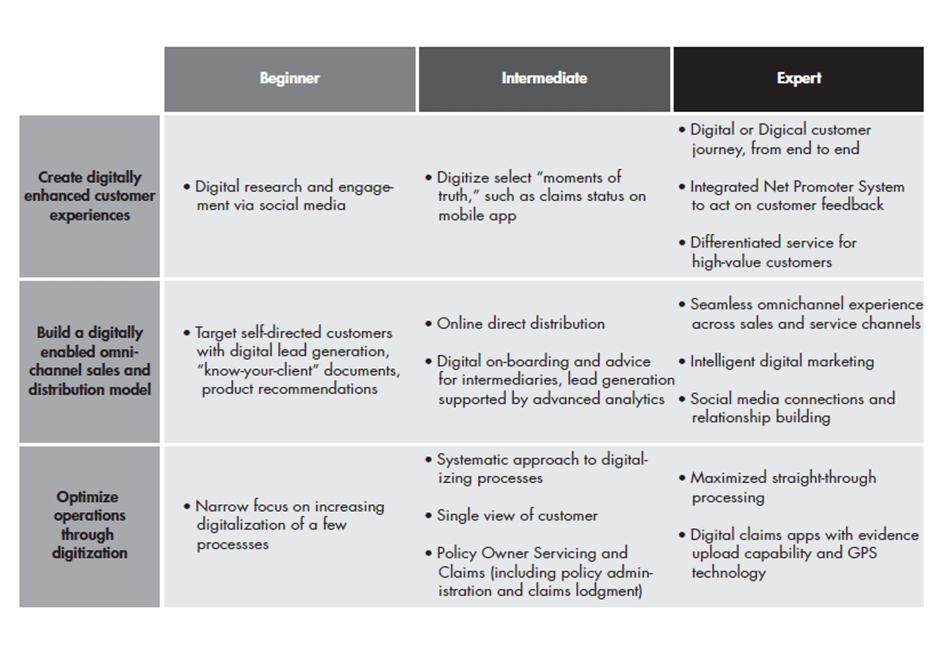
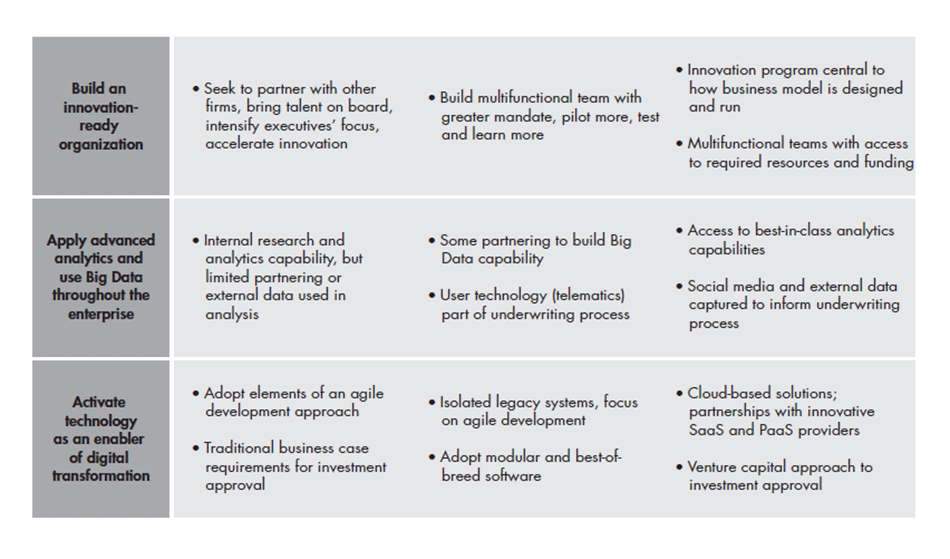
Bain & Company partners Harshveer Singh, Gunther Schwarz, Henrik Naujoks and Andrew Schwedel are members of the firm’s Global Financial Services practice. They are based, respectively, in Singapore, Düsseldorf, Düsseldorf and New York.
Bain is working with major insurers worldwide to benchmark their current performance on multiple digital dimensions. We plan to report on that benchmarking in 2015.
Digical® is a trademark of Bain & Company, Inc.
Net Promoter ScoreSM is a trademark of Bain & Company, Inc., Fred Reichheld and Satmetrix Systems, Inc.




